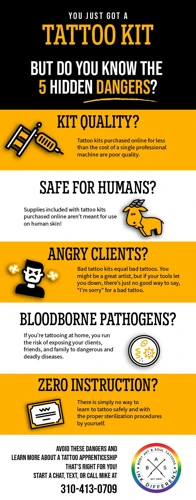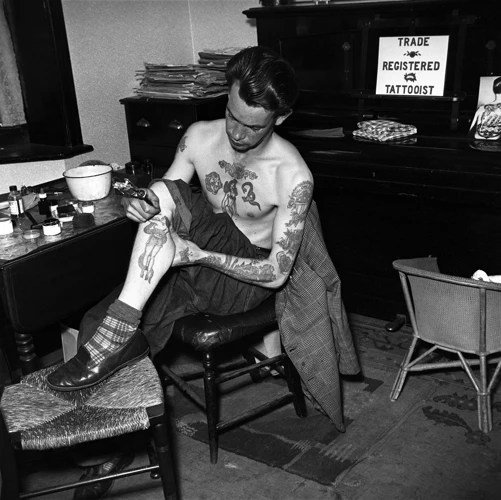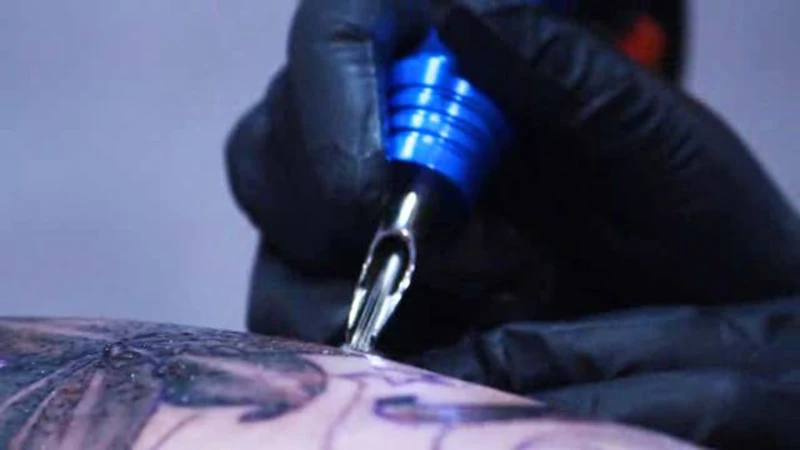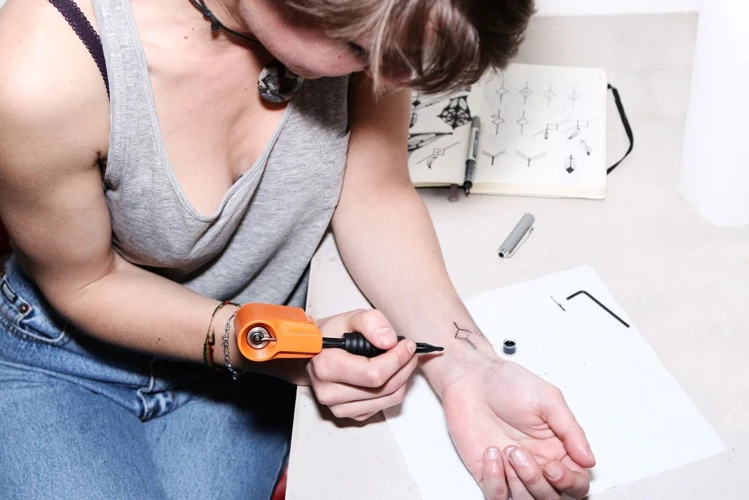If you’ve ever wondered how to tattoo yourself at home with a gun, this step-by-step guide will show you how. You can learn how to safely and effectively tattoo yourself with a gun and create your own custom designs. This guide will cover the basics of choosing the right gun, preparing the supplies, and following the proper steps to ensure a successful tattoo. With the right amount of preparation and safety, you can successfully create a unique tattoo at home with a gun.
Contents
Safety Precautions

Disinfection: Before starting to tattoo yourself, it is important to disinfect the area. You should use a medical-grade disinfectant to clean the surface of your skin. Additionally, it is a good idea to use alcohol to clean the gun and needles.
Allergy Test: Before getting a tattoo, it is important to test for allergies. You should use a small amount of the ink on a patch of your skin and wait 24 hours to see if there are any reactions.
Clothing: It is important to wear clothing that is comfortable when getting a tattoo. Avoid wearing clothes that are too tight as they can cause discomfort when working.
Gloves: It is important to wear gloves when doing a tattoo. This will protect your hands from any potential infections.
Needles: It is important to use only new needles when doing a tattoo at home. Old needles can potentially cause infections and should be avoided.
Design

Stencils
Stencils are pre-cut stencils of the desired design which are applied to the skin. This is the most accurate way to ensure the tattoo design is placed correctly and the lines are crisp and even.
Freehand
Freehand tattoos are created with no stencils, and are done completely by hand. This requires a very steady hand and a great deal of artistic skill.
Placement
When deciding where to place the tattoo, it is important to consider the size, shape, and design of the tattoo. Smaller tattoos can be placed almost anywhere, while larger tattoos should be placed on larger areas of the body, such as the back or arms. It is also important to consider how visible the tattoo will be, as it can be seen more easily on certain parts of the body.
Preparation

Skin Cleaning
Before beginning the tattoo, ensure the area of skin to be tattooed is clean and dry. Use an antibacterial soap and warm water to thoroughly clean the area. Rinse with cold water to close the pores. Pat dry with a clean towel.
Power Supply
Attach the power supply to the tattoo gun. Ensure the power supply is connected to a working outlet, and that the power switch is in the “on” position. Adjust the voltage of the power supply to the desired setting.
Tattoo Application

Gun Assembly
Assemble the tattoo gun using the parts provided in the kit. Make sure the parts are all properly connected.
Setting the Needle
Insert the needle into the gun and secure it by tightening the set screw. Make sure that the needle is properly connected and securely fastened in place.
Ink Application
Fill the ink tube with the ink of your choice. Make sure that the ink is not too thick or too thin.
Depth
Adjust the depth setting on the gun according to the desired effect. For a light tattoo, set the depth to shallow. For a darker tattoo, set the depth to deeper.
Color
Choose the color of the ink to be used. Make sure that the color is not too bright or too dull.
Aftercare
Moisturizing
Once your tattoo is completed, it is important to keep it moisturized. Use a mild, fragrance-free lotion or moisturizer to keep the skin hydrated and to help the healing process. Apply the moisturizer several times a day, as needed.
Wound Care
It is important to keep the tattooed area clean and to avoid any contact with dirt, debris, and other irritants. Gently wash the area with mild soap and warm water twice a day. Pat the area dry and apply a thin layer of moisturizer.
Avoiding Infection
It is important to take steps to avoid infection when tattooing yourself. Wash your hands before and after tattooing. Make sure the tattooing area is clean and disinfected. Avoid touching the area with your hands or any other object. If you notice any signs of infection, such as redness, swelling, or pus, seek medical attention immediately.
Frequently Asked Questions
What are the Safety Precautions I Should Take When Tattooing Myself at Home?
Sanitation:
- Disinfect all tools and surfaces with rubbing alcohol or other medical-grade disinfectant.
- Wash your hands with soap and warm water and wear gloves.
- Do not reuse needles or any other supplies.
Protective Gear:
- Wear protective eyewear.
- Wear a face mask.
- Wear gloves.
Preparing the Skin:
- Shave the area where you will be tattooing.
- Clean the area with rubbing alcohol.
- Apply a thin layer of petroleum jelly or a skin numbing cream.
- Wait 10 minutes before beginning.
Tattooing:
- Use a steady hand when tattooing.
- Do not tattoo over an open wound.
- Do not push the tattoo gun too hard into the skin.
- Do not tattoo over an area that is already bruised.
- Do not tattoo an area that has been stretched or stretched too much.
Aftercare:
- Clean the area with lukewarm water and a mild soap.
- Apply a thin layer of petroleum jelly or a healing ointment.
- Cover the area with a clean bandage.
- Keep the area clean and dry.
- Avoid direct sunlight, hot tubs, and swimming for at least two weeks.
What type of gun should I use for a DIY tattoo?
- Rotary Tattoo Machine – A rotary tattoo machine is the most popular type of machine and is preferred by most tattoo artists because it is easy to use and produces a consistent, high-quality tattoo. It is powered by an electric motor and has a needle at the end of a small arm that moves in a circular motion, creating the design on the skin.
- Coil Tattoo Machine – A coil tattoo machine is the second most common type of machine and is louder than a rotary machine. It is powered by a spring-loaded arm that moves the needle up and down, creating the design on the skin.
- Pneumatic Tattoo Machine – A pneumatic tattoo machine is powered by compressed air and is quieter than a rotary or coil machine. It is lightweight, easy to use, and produces a consistent, high-quality tattoo.
When it comes to DIY tattoos, it is best to use a rotary tattoo machine. It is the easiest to use and produces the best results.
Do I need to be experienced in tattooing to do this safely?
- Yes, you need to have some experience in tattooing in order to do it safely. This is because the process of tattooing requires a certain level of skill and knowledge.
- You need to have a good understanding of hygiene and safety protocols, as well as the ability to properly use the tattoo gun.
- You should also be familiar with the anatomy of the skin, as well as the different types of needles and inks that are used.
- It is also important to have a good understanding of the different types of designs and how to apply them correctly.
- Finally, you need to be aware of the potential risks associated with the procedure, such as infection and scarring.
In summary, it is essential that you have some level of experience in tattooing before attempting to do it at home.
What type of ink should I use for a DIY tattoo?
Safety: When it comes to tattooing yourself, safety should be your top priority. Make sure to only use ink that is specifically designed for tattoos and has been approved by the FDA.
Types of Ink:
- Pigment-based inks: These inks are the most popular option for tattoos. They are made with a combination of pigments and other ingredients, and are safe for use on the skin.
- Vegan inks: Vegan inks are made without animal products and are a great option for those who prefer a more natural approach.
- Glow-in-the-dark inks: Glow-in-the-dark inks are a fun option, but they are not recommended for use on the skin as they may cause irritation.
Considerations: Be sure to do your research before using any type of ink for a DIY tattoo. Some inks may contain ingredients that can cause skin irritation or even an allergic reaction. It is important to test a small amount of the ink on your skin before using it for a full tattoo.
What type of needle should I use for a DIY tattoo?
It is important to use the right type of needle for a DIY tattoo. The most common needle used for tattooing is the round liner needle, which is used to create outlines and details. It is also possible to use a shader needle for shading and coloring, which has a flat tip and usually comes in a group of needles of different sizes. When choosing needles, make sure to go for high-quality options that are sterile and disposable.
Conclusion
Tattooing yourself at home with a gun can be a safe and rewarding experience if done responsibly. Following the steps outlined in this guide, you can help ensure that your new tattoo is done safely, professionally, and looks great. With the right supplies and knowledge, you can create a piece of art that you can proudly display.